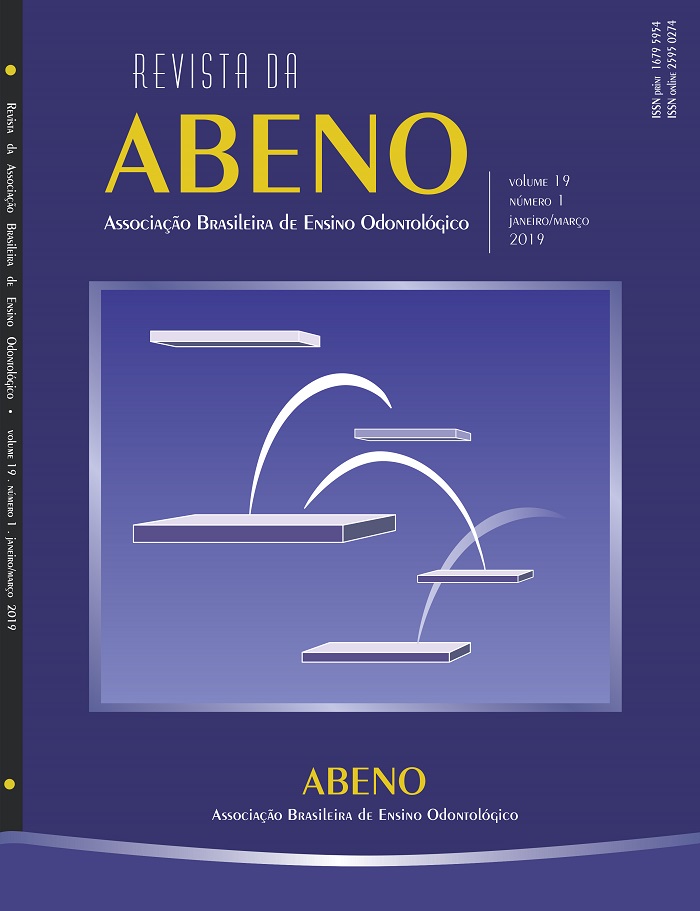Evolution of students' self-confidence and trust after learning in periodontics manikins
DOI:
https://doi.org/10.30979/rev.abeno.v19i1.783Keywords:
Educational Measurement. Trust. Manikins. Periodontics. Laboratories, Dental.Abstract
Simulation in health education is a tool that allows the student to learn in a protected and controlled environment, free from intercurrences and with instant feedback of the task performed. Simulation assists the instructor to evaluate the procedure performed and allows them to intervene at any moment, warning or instructing the student. This study aimed to evaluate the evolution of students’ self-confidence and trust after simulated learning in a manikin during a curricular component of Periodontics and its correlation with practical performance. Questionnaires using visual analog scale (VAS), 101-point numeric rating scale (NRS-101) and 4-point verbal rating scale (VRS-4) were applied to students enrolled in Periodontics I course at the Federal University of Paraná, Curitiba, Brazil, in the first term of 2018, in three different moments: 1) before the beginning of the practical activities; 2) after the laboratory phase; and 3) after the clinical phase. The data from the questionnaires were correlated with the final practical performance. Students reported being more self-confident and secure at the end than the beginning of the term (Friedman; p<0.05). This evolution was noted mainly between the first and second questionnaire applications, after the laboratory phase with simulation. There was a correlation between self-confidence and trust measured in NRS-101 and the practical performance (Spearman; r=0.3948 and r=0.3771, respectively; p<0.05). Students’ self-confidence and trust increased after simulated learning, which was slightly more valuable for the evolution of these aspects in comparison to the clinical experience.
Downloads
References
Dourado ASS, Giannella TR. Ensino baseado em simulação na formação continuada de médicos: análise das percepções de alunos e professores de um hospital do Rio de Janeiro. Rev Bras Educ Méd. 2014;38(4):460-9.
Mariani AW, Pêgo-Fernandes PM. Ensino médico: simulação e realidade virtual. Diagn Tratamento. 2012;17(2):47-8.
Iglesias AG, Pazin-Filho A. Emprego de simulações no ensino e na avaliação. Medicina (Ribeirão Preto). 2015;48(3):233-40.
Lee JS, Graham R, Bassiur JP, Lichtenthal RM. Evaluation of a local anesthesia simulation model with Dental students as novice clinicians. J Dent Educ. 2015; 79(12):1411-7.
Brand HS, Baart JA, Maas NE, Bachet I. Effect of a training model in local anesthesia teaching. J Dent Educ. 2010;74(8):876-9.
Michaelis Moderno Dicionário da Língua Portuguesa, 2015. [Acesso em 20 ago. 2018]. Disponível em: https://michaelis.uol.com.br/ moderno-portugues/busca/portugues-brasi leiro/
Costa RRO, Medeiros SM, Martins JCA, Menezes RMP. O uso da simulação no contexto da educação e formação em saúde e enfermagem: uma reflexão acadêmica. Espaç Saúde. 2015;16(1):59-65.
Volkweis MR, Oliveira AR, Faria FR, Wagner JCB, Gomes JP. Avaliação de uma técnica de exodontia em laboratório como instrumento de ensino - estudo piloto. Rev Cir Traumatol Buco-Maxilo-Fac. 2003; 3(1):31-6.
Tanalp J, Güven EP, Oktay I. Evaluation of dental students’ perception and self-confidence levels regarding endodontic treatment. Eur J Dent Educ. 2013;7(2):218-24.
Celik Y, Ceylantekin Y. The evaluation of simulation market in nursing education and the determination of learning style of students. Int J Health Sci. 2017;11(1):13-8.
Arigbede A, Denloye O, Dosumu O. Use of simulators in operative dental education: experience in southern Nigeria. Afr Health Sci. 2015;15(1):269-77.
Heym R, Krause S, Hennessen T, Pitchika V, Ern C, Hickel R. A new model for training in periodontal examinations using manikins. J Dent Educ. 2016;80(12):1422-9.
Varga CRR, Almeida VC, Germano CMR, Melo DG, Chachá SGF, Souto BGA, et al. Relato de experiência: o uso de simulações no processo de ensino-aprendizagem em Medicina. Rev Bras Educ Med. 2009; 33(2):291-7.
Prasad S, Bansal N. Predoctoral Dental students’ perceptions of dental implant training: effect of preclinical simulation and clinical experience. J Dent Educ. 2017;81(4): 395-403.
Hjermstad MJ, Fayers PM, Haugen DF, Caraceni A, Hanks GW, Loge JH, et al. Studies comparing numerical rating scales, verbal rating scales, and visual analogue scales for assessment of pain intensity in adults: a systematic literature review. J Pain Symptom Manage. 2011 41(6):1073-
Jensen MP, Karoly P, Braver S. The measurement of clinical pain intensity: a comparison of six methods. Pain. 1986 27(1):117-26.
Downloads
Published
How to Cite
Issue
Section
License
Autores que publicam nesta revista concordam com os seguintes termos:
a) Autores mantém os direitos autorais e concedem à revista o direito de primeira publicação, com o trabalho simultaneamente licenciado sob a Licença Creative Commons Attribution que permite o compartilhamento do trabalho com reconhecimento da autoria e publicação inicial nesta revista.
b) Autores têm autorização para assumir contratos adicionais separadamente, para distribuição não-exclusiva da versão do trabalho publicada nesta revista (ex.: publicar em repositório institucional ou como capítulo de livro), com reconhecimento de autoria e publicação inicial nesta revista.
c) Autores têm permissão e são estimulados a publicar e distribuir seu trabalho online (ex.: em repositórios institucionais ou na sua página pessoal) a qualquer ponto antes ou durante o processo editorial, já que isso pode gerar alterações produtivas, bem como aumentar o impacto e a citação do trabalho publicado (Veja O Efeito do Acesso Livre).






